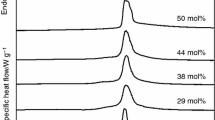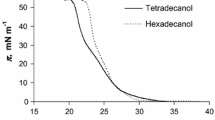Summary
The interaction of permeant molecules such as glycerol and urea and nonpermeants such as trehalose, sucrose, lactose and glucose with dipalmitoylphosphatidylcholine (DPPC) and egg yolk phosphatidylcholine (EPC) bilayers was studied by means of infrared spectroscopy in solid samples. The properties of the liposomes formed upon rehydration in different polyol solutions were determined by dynamic light scattering, fluorescence anisotropy, absorbance at 450 nm and merocyanine 540 spectra.
Phospholipid samples dehydrated in the presence of urea and glycerol give Δv 1/2 values for the antisymmetric stretch (P=0 stretch) in the IR spectra; lower values are found for hydrated phospholipids.
In contrast, the same procedure in the presence of carbohydrates, gives Δv 1/2 values close or higher to those found for hydrated phospholipids, following the sequence glucose>sucrose>trehalose. This order is similar to that found in hydrated bilayers for the 570/500 nm ratio determined in the MC 540 spectra as a function of the number of OH equatorial groups of the sugars.
Liposomes lyophilized in the presence of those carbohydrates and rehydrated in buffer solution showed an increase in the 570/530 absorbance ratio in the MC spectra at temperatures below that corresponding to the gel-liquid crystalline transition. This is interpreted as an exposure of hydrophobic regions due to the carbohydrate-phospholipid interaction. In these conditions, the size at which liposomes spontaneously stabilize is a function of the type and concentration of the polyols in the aqueous solution. These changes in size are connected with packing and mechanical constraints of the bilayer for some of the sugars assayed.
Similar results to those obtained with lyophilized liposomes were found after aging liposomes in high sugar concentration solutions. A clear distinction can be made between the effect of permeant and nonpermeant molecules in regard to size, packing and hydrophobic region exposure.
Similar content being viewed by others
References
Arnett, E.B., Harvey, N., Johnson, E.A., Johnson, D.S., Chapman, D. 1985. No phospholipid monolayer-sugar interaction.Biochemistry 25:5239–5242
Bangham, A.D., Hill, M.W., Miller, N.G.A. 1974. Preparation and use of liposomes as models of biological membranes.In: Methods in Membrane Biology. Vol. 11, pp.1–68. E.D. Korn, editor. Plenum, New York
Cadenhead, D.A., Bean, K.E. 1972. Selected lipid monolayers on aqueous-glycerol and aqueous-urea substrates.Biochim. Biophys. Acta 290(1):43–50
Cohen, B.E. 1975. The permeability of liposomes to non-electrolytes. I. Activation energies for permeation.J. Membrane Biol. 20:205–234
Crowe, J.H., Crowe, L.M., Chapman, D. 1984. Preservation of membranes in anhydrobiotic organisms: The role of trehalose.Science 223:701–703
Crowe, J.H., Whitlam, M.A., Chapman, D., Crowe, L.M. 1984. Interactions of phospholipid monolayers with carbohydrates.Biochim. Biophys. Acta 769:151–159
Crowe, L.M., Mouradian, R., Crowe, J.H., Jackson, S.A., Womersley, C. 1984. Effect of carbohydrates on membrane stability at low water activities.Biochim. Biophys. Acta 769:141–150
De Gier, J., Mandersloot, J.G., Hupkes, J.V., McElhaney, R.N., Van Beek, W.P. 1971. On the mechanism of non-electrolyte permeation through lipid bilayers and through biomembranes.Biochim. Biophys. Acta 233:610–618
Disalvo, E.A. 1985. Thermodynamic factors determining the permeability barrier properties of lipid bilayers.Chem. Phys. Lipids 37:385–397
Disalvo, E.A. 1987. Leakage from egg phosphatidylcholine sonicated vesicles induced by Ca+2 and alcohol.Biochim. Biophys. Acta 905:9–16.
Disalvo, E.A., De Gier, J. 1983. Contribution of aqueous interfaces to the permeability barrier of lipid bilayers for non electrolytes.Chem. Phys. Lipids 32:39–47
Geurts Van Kessel, W.S.M., Tieman, M., Demel, R.A. 1981. Purification of phospholipid by preparative high pressure liquid chromatography.Lipids 16:58–63
Gruner, S.M. 1985. Intrinsic curvature hypothesis for biomembrane lipid composition: A role for nonbilayer lipids.Proc. Natl. Acad. Sci. USA 82:3665–3669
Lelkes, P.I., Miller, I.R. 1980. Perturbations of membrane structure by optical probes: I. Location and structural sensitivity of merocyanine 540 bound to phospholipid membranes.J. Membrane Biol. 52:1–15
Maggio, B., Lucy, J.A. 1978. Interactions of water-soluble fusogens with phospholipids in monolayers.FEBS Lett. 94:301–304
McDaniel, R.V., McIntosh, T.J., Simon, S.A. 1983. Non-electrolyte substitution for water in phosphatidylcholine bilayers.Biochim. Biophys. Acta 731:97–108
Pouchert, C.J. (ed.) 1970. The Aldrich Library Spectra. Aldrich Chemical, Milwaukee
Rudolph, A.S., Crowe, J.H., Crowe, L.M. 1986. Effects of three stabilizing agents—proline, betaine and trehalose—on membrane phospholipids.Arch. Biochem. Biophys. 245(1):134–143
Strauss, G., Schurtenberger, P., Hauser, H. 1986. The interaction with lipid bilayers vesicles: Stabilization during freeze-thawing and freeze-drying.Biochim. Biophys. Acta 858:169–180
Veiro, J.A., Nambi, P., Herold, L.L., Rowe, E.S. 1987. Effect ofn-alcohols and glycerol on the pretransitions of dipalmitoylphosphatidylcholine.Biochim. Biophys. Acta 900:230–238
Author information
Authors and Affiliations
Rights and permissions
About this article
Cite this article
Alonso-Romanowski, S., Biondi, A.C. & Disalvo, E.A. Effect of carbohydrates and glycerol on the stability and surface properties of lyophilized liposomes. J. Membrain Biol. 108, 1–11 (1989). https://doi.org/10.1007/BF01870420
Received:
Revised:
Issue Date:
DOI: https://doi.org/10.1007/BF01870420




